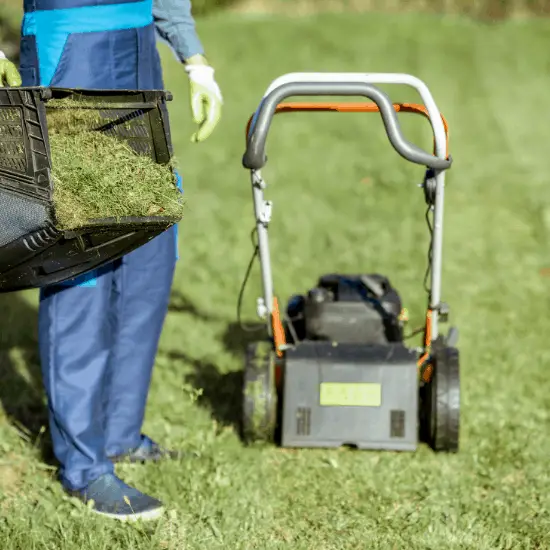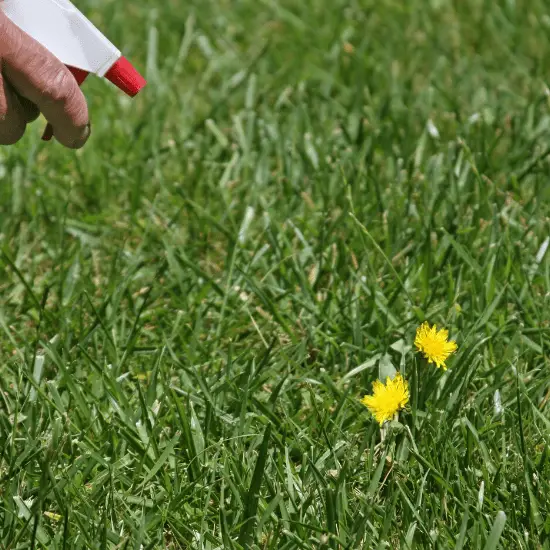It is no secret that lawn weeds are a common problem for homeowners around America. This is especially true during spring and fall when weeds are able to thrive because of peak growing conditions.
While at least some weed growth is inevitable in the majority of lawns, the desire of many homeowners is to have as few weeds as possible. While there are many solutions to eliminate or reduce weed growth, this article will take a look at the impact that grass clippings have on spreading weeds. Specifically, we will answer the question, “should you bag grass clippings if you have weed?”.
Table of Contents
Bagging Grass Clippings and Weeds

Clippings that are mulched or side discharged are sliced up by the lawn mower blade then deposited back on the lawn. These clippings can contain weed seed that makes its way down to the lawn soil where it can sprout new weeds.
Bagging grass clippings can reduce the amount of weeds spread. When clippings are bagged, the grass blades are not only collected, but also weeds and their seeds. The potential to spread weed seed is reduced when these clippings are bagged and properly disposed of in something like a yard waste bag.
Keep in mind that you will not completely eliminate spreading weeds by bagging. Firstly, the lawn mower does not collect every grass blade or weed it mows over. Some end up back on the lawn with the potential to spread weed seed.
Furthermore, the blade, deck, and other parts of the lawn mower can collect weed seed to only later drop it as the mower moves around the yard.
Lastly, mowing and bagging does not put an end to the possibility of weeds still remaining in the lawn. In other words, just because a weed has been mowed over does not mean it will no longer spread weeds or even die off.
Unnecessary Bagging
You shouldn’t worry about bagging if your lawn is taken over by weeds (i.e. mostly weeds with bare spots). It’s time to start thinking about a lawn renovation that will completely revamp your lawn.
A lawn renovation involves killing off the existing grass/weeds and starting over by planting new sod or grass seed. You can read more about the lawn renovation process here. Feel free to mow however you like if your lawn is in need of a lawn renovation. Once your new lawn is established, you can develop a game plan for mulching and/or bagging.
On the other extreme, a lawn with a couple of weeds scattered throughout the lawn does not require bagging. If you are worried about your lawn mower spreading these weeds, you can simply manually dig them out with a lawn weeder tool or spot weed spray them later and proceed to mulch. As we will explain, mulching is much better for the health of a lawn than bagging. Typical the goal should be to mulch when possible.
Benefits of Mulching
A lawn mower equipped with a mulching blade cuts the grass into tiny pieces. These tiny pieces fall to the lawn soil where they decompose quickly.
The clipping act as a natural fertilizer for the lawn by providing nitrogen, potassium, and phosphorus. These are the same nutrients in the bagged fertilizers (i.e. Scotts) found at stores such as Home Depot and Lowe’s.
By mulching grass clippings, you can reduce the annual amount of store bought fertilizer needed for your lawn. You may also lower your watering needs since mulched clippings help keep the lawn hydrated.
Mulching can also minimize costs since there is no stopping and starting the mower to waste gas emptying the bagger. Additionally, there is no need for the use of lawn refuse bags or similar products to dispose of the clipping.
Lastly, mulching is more environmentally-friendly than bagging. The job gets down faster so you are burning less gas by mulching. Furthermore, mulching does not require the clippings to be hauled away by a waste management professional to a landfill.
Taking Care of Weeds

In order to obtain a lawn that is near weed-free, you will need to take steps to control the weeds. If your weeds are not excessive, we recommend spot spraying them with a product like Weed-B-Gon. Weed-B-Gon kills over 200 types of weeds including dandelions, clover, thistles, and other common weeds you may be likely to see.
By spot spraying, you eliminate the need to excessively apply chemicals to the lawn since you are only targeting the weeds. Compare this to using a granular product like a weed and feed where you indiscriminately lay down a blanket of weed killer.
We would only recommend weed and feed products if the weeds are heavy. Heavy does not mean the weeds greatly outnumber the grass, but are significant enough to warrant a blanket coverage of granular weed killer. As we indicated earlier, a lawn that is largely weeds should be completely renovated (killed and replanted) in many cases, instead of trying to win the uphill battle of weed control.
Consider Organic
We have used a combination of the spot spray method with organic fertilizer to kill weeds and feed the lawn for years now. We have received stellar fertilizer results by using Milorganite over these years. Milorganite is a favorite of people who prefer a more natural approach over synthetic fertilizer.
A 32 pound bag covers 2,500 square feet and is applied four times a year, if local ordinances allow it. The best part about Milorganite is that it is non-burning, so if you happen to over apply it, you won’t have a brown lawn.
The one downside to Milorganite is that its price has significantly increased in recent years. We have been looking for alternatives that are comparable but more budget-friendly. Additionally, be aware that if you use Milorganite, it won’t kill weeds. It is only designed to feed the lawn to make it lush and green.
The below table provides some options for organic/natural fertilizers and/or weed killers. These are worth a look if you are seeking alternatives to less environmental-friendly synthetic fertilizers. Most of these will not kill weeds. You will have to also purchase a weed killer (i.e. Weed-B-Gon) or manually pull them if weeds are a problem for you.
| Image | Product Name | Purpose | Coverage | See More |
|---|---|---|---|---|
 | Milorganite - 32 pound bag | Fertilizer (6-4-0 NPK) | 2,500 sq ft | See More |
 | Safer Brand Lawn Restore | Fertilizer (9-0-2 NPK) | 6,250 sq ft | See More |
 | Simple Lawn Solutions Lawn Food | Fertilizer (16-4-8 NPK) | 3,200 sq ft | See More |
 | Espoma Organic Weed Preventer | Fertilizer/Weed Preventer | 1,250 sq ft | See More |
 | The Andersons Innova Organic | Fertilizer (7-1-2 NPK) | About 4,000 sq ft | See More |
 | Lawnstar Fertilizer + Seaweed | Fertilizer (16-4-8 NPK) | 4,000 sq ft | See More |
 | Jonathan Green Organic Lawn Food | Fertilizer (10-0-1 NPK) | 5,000 sq ft | See More |
 | Pet Safe Lawn Fertilizer | Fertilizer (24-0-6 NPK) | 5,000 sq ft | See More |
 | Espoma Organic All Season Lawn Food | Fertilizer (9-0-0 NPK) | 5,000 sq ft | See More |

